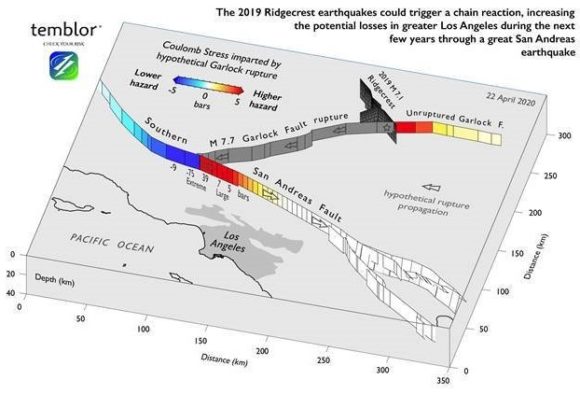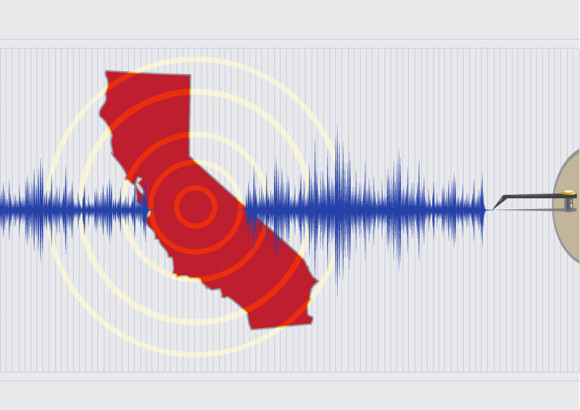Get ready for the big one.
That’s a refrain Californians have heard for years, but this time one scientist is putting a number on it.
There’s a 1% chance a big quake will strike next year on the Southern section of the San Andreas Fault, according to Ross S. Stein, Ph.D., CEO of Temblor Inc., a catastrophe risk modeling company based in Redwood City, Calif.
That may not sound that high, but it’s a lot higher than previously believed.
Stein and scientist Shinji Toda, Ph.D., with Tohoku University, published a paper that went out to the public this week in the Bulletin of the Seismological Society of America, “Long- and Short-Term Stress Interaction of the 2019 Ridgecrest Sequence and Coulomb-Based Earthquake Forecasts.”
The crux of the paper is that the 2019 Ridgecrest quakes stressed the Garlock Fault, which if it ruptured in a large shock, would likely trigger a San Andreas earthquake north of Los Angeles.
“What’s happened is the Ridgecrest Earthquake took a 1-in-300 (year) event and made it a 1-in-100 event,” said Stein, who was formerly with the U.S. Geological Survey. “That’s a big change. For Southern California, this means that probabilistic losses are much higher.”
The Ridgecrest ruptures could have far-reaching effects because the Garlock Fault links the Ridgecrest faults with the San Andreas Fault, according to the paper.
Stein explained using the letter “Z” to illustrate the connections between the faults. The Ridgecrest Fault is the top horizontal line, which ruptured in a M7.1 quake last year, is connected to Garlock Fault, which runs northeast–southwest along the norther margins of the Mojave Desert and is the diagonal of the Z. And the bottom of the Z is San Andreas.
“The first one has gone, the second one could go,” Stein said.
If the Garlock Fault produces a very large earthquake, then the chances of a quake on the Southern section of the San Andreas rises to 50-50 in the ensuing year, according to him.
The Ridgecrest are Garlock Faults are in areas with sparse populations, but a major quake on the San Andreas near Los Angeles would be costly.

Stein estimates the damages from such an earthquake – a roughly a 7.7M on the Mojave section of the San Andreas Fault – could exceed $40 billion.
“We’re at least talking about a $40 billion event,” he said.
Research in the last 10 years has shown that the shaking in L.A. could last much longer, and be stronger, than previously realized.
The Northridge Quake in 1994 was a M6.7 and lasted roughly 10 to 20 seconds. Stein said in a massive San Andreas quake, buildings in Los Angeles could be shaking for more than 100 seconds. A M7.7 is about 33 times larger than a M6.7.
“Duration is a big factor,” he said.
Why this matters to insurance professionals is that virtually all California insurance premiums are tied to UCERF3 earthquake rates. UCERF3 – Uniform California Earthquake Rupture Forecast, Version 3 – shows a M7.7 on the Mojave section of the San Andreas Fault has an occurrence rate of 0.35% per year. That’s makes it roughly a one-in-300 year event each year.
Stein and Toda in their paper now estimate the chance of a large San Andreas earthquake in Southern California the next 12 months to be 1.15%.
“Now we’re saying next year it’s about a one-in-100 event,” Stein said. “What our goal is, is to enable insurers to understand how has their exposure changed.”
That’s the message to the insurance community.
“The message that we are sending to the public is the sky is not falling, don’t panic,” he said. “What we are saying that a southern San Andreas has a 1% chance of occurring next year. That also means there’s a 99% chance of not occurring.”
Then he added: “This is a really good time to decide if you need to protect yourself better.”
Related:
- No Damage, Injuries from M4.6 Earthquake in Central California
- Updated Residential Earthquake Damage Guidelines for California Released
- Magnitude 5.5 Earthquake Confirmed in California Desert Region
Topics California Catastrophe Earthquake
Was this article valuable?
Here are more articles you may enjoy.



 Wall Street Pushes Back After Activists Escalate Protests
Wall Street Pushes Back After Activists Escalate Protests  Damage From Hurricane Beryl May Cost Insurers $2.7B in US, $510M in Caribbean: KCC
Damage From Hurricane Beryl May Cost Insurers $2.7B in US, $510M in Caribbean: KCC  Insurers Hike Rates as Extreme Storms Like Beryl Proliferate
Insurers Hike Rates as Extreme Storms Like Beryl Proliferate  Project 2025 Plan to End NFIP Welcomed by Some, Rejected by Others in Insurance
Project 2025 Plan to End NFIP Welcomed by Some, Rejected by Others in Insurance 

